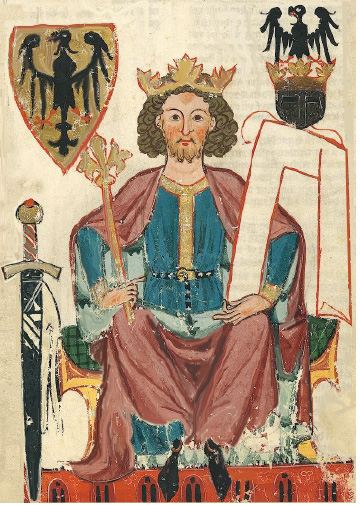...Best of Sicily presents... Best of Sicily Magazine. ... Dedicated to Sicilian art, culture, history, people, places and all things Sicilian. |
by Luigi Mendola | |||
Magazine Index Best of Sicily Arts & Culture Fashion Food & Wine History & Society About Us Travel Faqs Contact Map of Sicily
|
The conflicts took slightly different forms in different kingdoms, whether in England, Sicily or the various realms forming the Holy Roman Empire, but in every instance it was a question of a king refusing to bow to Papal authority in domestic matters having little if anything to do with religion. In England the greatest conflicts began with Henry II and Thomas Becket, culminating (in a sense) with Henry VIII centuries later, while in Sicily every monarch from Roger I to Frederick II (who was actually excommunicated) had to deal with meddlesome Pontiffs. In the Holy Roman Empire the dynasty facing Papal wrath was the Hohenstaufen family of Swabia, who eventually claimed the Throne of Sicily, and the man to do that was Henry VI. Born in 1165, Henry, son of the imposing Frederick Barbarossa and Beatrice of Burgundy, was King of the Germans (from 1169) and Holy Roman Emperor (from 1191). Historians believe that the key to his expansionist ambitions was the Kingdom of Sicily, which then encompassed all of Italy south of Rome and a few Mediterranean coastal areas in the Balkans and northern Africa; Italy's northern city-states were already a nominal part of his Empire. Having wed Constance, posthumous daughter of Roger II of Sicily, Henry claimed by marital right to be the heir of William II of Sicily, who died without issue in 1189, though Constance's nephew Tancred also claimed the Sicilian Throne. (Tancred was the illegitimate son of Roger II's eldest son, Roger of Apulia.) Two years later, following Henry's coronation as Emperor in Rome, his armies were marching through Italy toward Sicily to oust Tancred, but this expedition was doomed to failure as the result of machinations back in Germany by princes aided by Richard Lionheart, necessitating Henry's return to rein in some rebellious nobles. Conspiracies aside, Henry didn't like the fact that Richard had recognized Tancred as King of Sicily. By early 1194, with the death of Tancred, the last (adult) male Hauteville claimant, the way was clear for a second invasion by Henry and Constance. In the meantime, since March 1193, the annoying Lionheart had become Henry's prisoner, thus removing one more thorn from his side. Pope Celestine III excommunicated Henry for imprisoning a fellow Crusader, but following payment of a hefty ransom Richard was released in February 1194. (Incidentally, as it has come down to us, the phrase a king's ransom may be rooted in this historical event.) By the time Henry arrived in Palermo, his wife had given birth en route to an heir, christened Frederick Roger, known to us as Frederick II. From 1196 into the following year, the Hohenstaufen dynasty reached the greatest geographic and economic extent of its power. On paper, England and half of France were - however briefly - vassal states, while Denmark and Hungary more practically recognized Staufen authority over the long term. Moreover, two-thirds of Italy, in effect everything but the Papal State, was now under Henry's direct rule. Further afield, the kings of Armenia (which in those days stretched toward the Mediterranean) and the island of Cyprus became his vassals. The Emperor introduced numerous officials and vassals in Sicily. He brought the Teutonic Knights, establishing them at Messina and Palermo, where they would prove far more loyal than either the Hospitallers or Templars. None of this endeared him to the Norman and Lombard barons. This led, in 1197, to a ruthless suppression of armed revolts in Italy. Henry contemplated a conquest of Constantinople to take place in that same year. Led by Conrad, his faithful chancellor, the first contingent of this expedition had already departed when Henry died of malaria in Messina in September. Sicily's first German king is entombed in Palermo Cathedral where he was crowned. Next to his tomb are those of his wife and son.
About the Author: Historian Luigi Mendola has written for various publications, including this one. | ||
Top of Page |
 Beginning in the twelfth
century, western Europe became the battleground for a series of particularly
vociferous legalistic struggles between powerful monarchs and the Church
of Rome, the temporal authority of the latter greatly strengthened following
the
Beginning in the twelfth
century, western Europe became the battleground for a series of particularly
vociferous legalistic struggles between powerful monarchs and the Church
of Rome, the temporal authority of the latter greatly strengthened following
the